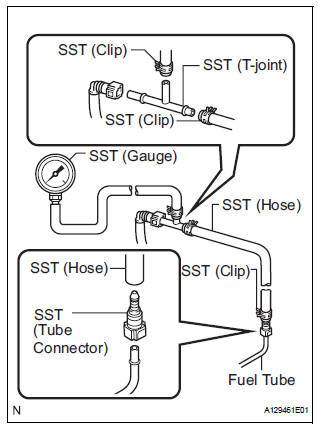Toyota Sienna Service Manual: On-vehicle inspection
1. INSPECT FOR FUEL PUMP OPERATION AND FUEL LEAK
(a) Check fuel pump operation.
(1) Connect the intelligent tester to the DLC3.
(2) Turn the engine switch on (IG) and push the intelligent tester main switch on.
| NOTICE: Do not start the engine. |
(3) Select the following menu items: DIAGNOSIS / ENHANCED OBD II / ACTIVE TEST / FUEL PUMP / SPD.
(4) Check for pressure in the fuel inlet tube from the fuel line. Check that sound of fuel flowing in the fuel tank can be heard. If no sound can be heard, check the integration relay, fuel pump, ECM and wiring connector.
(b) Check for fuel leaks (*1).
(1) Check that there are no fuel leaks anywhere on the system after performing maintenance. If there is a fuel leak, repair or replace parts as necessary.
(c) Turn the engine switch off.
(d) Disconnect the intelligent tester from the DLC3.
2. CHECK FUEL PRESSURE
(a) Discharge the fuel system pressure (See page FU- 1).
(b) Using a voltmeter, measure the battery voltage.
Standard voltage: 11 to 14 V
(c) Disconnect the cable from the negative (-) battery terminal.
(d) Disconnect the fuel hose from the fuel main tube (See page FU-1).

(e) Install SST (pressure gauge) using SST and a fuel tube connector as shown in the illustration.
SST 09268-31011 (09268-41500, 90467-13001, 95336-08070), 09268-45014 (09268-41200, 09268-41220, 09268-41250)
(f) Wipe up any gasoline.
(g) Connect the cable to the negative (-) battery terminal.
(h) Connect the intelligent tester to the DLC3.
(i) Select the following menu items: DIAGNOSIS / ENHANCED OBD II / ACTIVE TEST / FUEL PUMP / SPD.
(j) Measure the fuel pressure.
Fuel pressure: 304 to 343 kPa (3.1 to 3.5 kgf*cm2, 44.1 to 49.7 psi)
- If the fuel pressure is greater than the standard value, replace the fuel pressure regulator.
- If the fuel pressure is less than the standard value, check the fuel hoses and connections, fuel pump, fuel filter and fuel pressure regulator.
(k) Disconnect the intelligent tester from the DLC3.
(l) Start the engine.
(m) Measure the fuel pressure at idle.
Fuel pressure: 304 to 343 kPa (3.1 to 3.5 kgf*cm2, 44.1 to 49.7 psi)
(n) Stop the engine.
(o) Check that the fuel pressure remains as specified for 5 minutes after the engine stops.
Fuel pressure: 147 kPa (1.5 kgf*cm2, 21 psi) or more
If the fuel pressure is not as specified, check the fuel pump, pressure regulator and/or fuel injectors.
(p) After checking the fuel pressure, disconnect the cable from the negative (-) battery terminal and carefully remove the SST to prevent gasoline from splashing.
(q) Reconnect the fuel tube to the main fuel tube (fuel tube connector).
(r) Install the No. 1 fuel pipe clamp to the fuel tube connector.
(s) Check for fuel leaks (*1).
 Precaution
Precaution
1. PRECAUTION
(a) Before inspecting and repairing the fuel system,
disconnect the cable from the negative (-) battery
terminal.
(b) Do not smoke or work near fire when handling the
fuel system. ...
 Fuel injector
Fuel injector
...
Other materials:
Installation
HINT:
Use the same procedures for the RH side and LH side.
The procedures listed below are for the LH side.
1. INSTALL FRONT AIRBAG SENSOR LH
Check that the ignition switch is off.
Check that the battery negative (-) terminal is
disconnected.
CAUTION: ...
Meter panel light control
The brightness of the meter panel lights can be adjusted.
Pressing the button will adjust the
brightness of the meter panel
lights.
The brightness level of the meters
when the surroundings are bright
(day mode) and dark (night mode)
can be adjusted individually. However,
when in day ...
Rear window wiper and
washer
Operating the wiper lever
Turning the end of the lever turns on the rear window wiper and
washer.
The illustration is intended as an example.
*1 or
*2
Intermittent window
wiper operation
*1 or
*2
Normal window wiper
operation
Washer/wiper dual operation
Washer/wiper du ...
